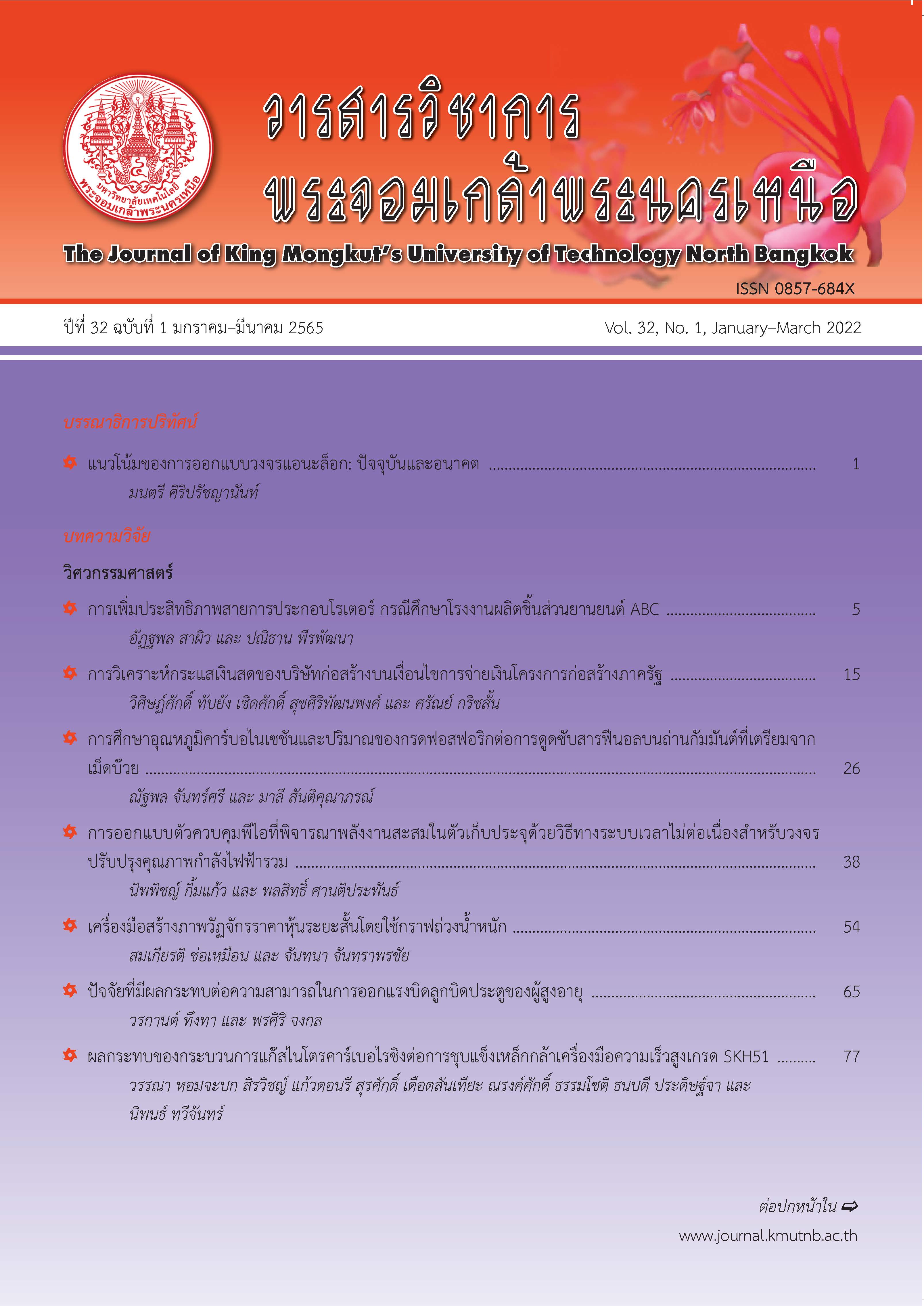ความสัมพันธ์ระหว่างรูปแบบเรขาคณิตเมืองกับการไหลของอากาศและสภาวะน่าสบายเชิงอุณหภาพ กรณีศึกษาเขตเทศบาลนครเชียงใหม่
Main Article Content
บทคัดย่อ
เมืองที่เป็นมิตรกับสิ่งแวดล้อมจำเป็นต้องสัมพันธ์กับธรรมชาติ งานวิจัยนี้จึงมีวัตถุประสงค์ในการศึกษาความสัมพันธ์ของลักษณะเรขาคณิตเมืองกับกระแสลม และสภาวะน่าสบายเชิงอุณหภาพ ภายในพื้นที่เทศบาลนครเชียงใหม่ โดยศึกษาอัตราส่วนความสูงอาคารและความกว้างถนนต่ออุณหภูมิพื้นผิว (H/W ratio) โดยใช้โปรแกรมพลศาสตร์ของไหล (CFD, Computational Fluid Dynamics) เพื่อทดสอบประสิทธิภาพของกระแสลมในรูปแบบการวางตัวของอาคารลักษณะต่างๆ ตามความหนาแน่นของเมือง 6 ระดับ คือ ร้อยละ 10 ไปจนถึง ร้อยละ 60 พบว่าพื้นที่ที่มีความหนาแน่นร้อยละ 40 ถึง 60 มีอุณหภูมิที่สัมพันธ์ทางบวกกับค่า H/W เนื่องจากพื้นที่มีอาคารสูง หนาแน่น และถนนแคบทำให้กระแสลมพัดผ่านในพื้นที่กระทบกับขอบของอาคาร การระบายลมช้าลงและมีบางจุดอับลมทำให้อุณหภูมิสูง อย่างไรก็ตามหากการวางตัวของอาคารไม่ขวางทิศทางลมจะส่งเสริมการระบายอากาศได้แม้จะอยู่ในพื้นที่ที่มีความหนาแน่นของอาคารมากก็ตาม และผลจากการแปลภาพถ่ายดาวเทียมเพื่อหาค่าดัชนีพืชพรรณนั้นแสดงค่าสัมพันธ์ทางลบกับค่าอุณหภูมิในพื้นที่อีกด้วย งานวิจัยได้ศึกษาสภาวะน่าสบายเชิงอุณหภาพ โดยการเก็บค่าอุตุนิยมวิทยาทางภาคสนาม เมื่อเปรียบเทียบอุณหภูมิ ความชื้นสัมพัทธ์ และความเร็วลมตามแผนภูมิไซไครเมตริก (Psychrometric Chart) พบว่าในพื้นที่ความหนาแน่นร้อยละ 30 ขึ้นไปเริ่มมีอุณหภูมิสูงเกินขอบเขตสภาวะน่าสบายเชิงอุณหภาพ ผู้วิจัยศึกษาการจัดการพื้นที่และอาคารโดยการเพิ่มพื้นที่สีเขียว การพิจารณาช่องเปิดของอาคาร และวิธีการระบายอากาศทางตั้ง สำหรับอาคารในพื้นที่ดังกล่าว และเสนอวิธีกำหนดความสูงของอาคารให้สัมพันธ์กับความกว้างของถนนสำหรับพื้นที่เมืองในอนาคต
Article Details
บทความที่ลงตีพิมพ์เป็นข้อคิดเห็นของผู้เขียนเท่านั้น
ผู้เขียนจะต้องเป็นผู้รับผิดชอบต่อผลทางกฎหมายใดๆ ที่อาจเกิดขึ้นจากบทความนั้น
เอกสารอ้างอิง
[2] Land Development Department. (2016). Chiang Mai Land use. [Online]. Available: http://www.ldd.go.th/www/lek_web/web.jsp?id=18907(accessed Mar. 20, 2019).
[3] D. E. Horton, C. B. Skinner, D. Singh, and N. S. Diffenbaugh, “Occurrence and persistence of future atmospheric stagnation events,” Nature Climate Change, vol. 4, no. 8, pp. 698–703, 2014.
[4] Northern Meteorological Center. (2019). Climatological data for the period 1981-2010, Chiang Mai. [Online]. Available: http://www.cmmet.tmd.go.th/forecast/climate.xls.
[5] J. Kitchai, “Thermal comfort of high-land people in Thailand during cool season,” in Proceedings Kasetsart University Annual Conference, 2007, no. 5, pp. 22–29 (in Thai).
[6] S. Zakhour, “The impact of urban geometry on outdoor thermal comfort conditions in Hot-arid region,” Journal of Civil Engineering and Architecture, vol. 2, no. 8, 2015.
[7] T. R. Oke, “Street design and urban canopy layer climate,” Energy Build, vol. 11, pp. 103–113, 1988.
[8] Thermal environmental conditions for human occupancy, ASHRAE Standard 55:1992, 1992.
[9] C. Yuan and E. Ng, “Building porosity for better urban ventilation in high-density cities - A computational parametric study,” Building and Environment, vol. 50, pp. 176–189, 2012.
[10] A. G. Davenport, “The treatment of wind loading on tall buildings,” in Proceedings of a Symposium on Tall Buildings with Particular Reference to Shear Wall Structures, 1967, pp. 3–45.
[11] T. Daranee and J. Chalermwat, “Natural ventilation: Planning design guidelines for residential high-rises,” Journal of Architectural/Planning Research and Studies, vol. 3, pp. 23–36, 2005 (in Thai).
[12] V. Olgyay, A. Olgyay, D. Lyndon, V. W. Olgyay, J. Reynolds, and K. Yeang, Design with Climate. New Jersey: Princeton University Press, 2016.
[13] S. Nittaya, Tropical Design Environment. Bankok, Thailand: Chulalongkorn University, 1998.
[14] N. Duangporn, Climatology. Bankok: Chulalongkorn University (in Thai).
[15] S. C. M. Hui, “Benefits and potential applications of green roof systems in Hong Kong,” presented at the 2nd Megacities International Conference, Guangzhou, China, December 2006.
[16] E. M. Elgizawy, “The effect of green facades in landscape ecology,” Procedia Environmental Sciences, vol. 34, pp. 119–130, 2016.
[17] V. Siriratchata, “A study of fenestration prototypes for Hot-Humid climata building,” M.S. thesis, Department of Architecture, Faculty of Architecture, Chulalongkorn University, 2007 (in Thai).
[18] B. Chumnan, “Stack effect ventilation,” Journal of Building Energy & Environment, vol. 2, no. 1, pp. 33–38, 2003 (in Thai).
[19] K.-S. Wong and E. Ng, “Policies towards greening, permeability and building separation for better city planning in Hong Kong,” Presented at 2nd International Conference on Countermeasures to Urban Heat, Islands, September, 2009.
[20] C. Wanpen, “Physical characteristics and ventilation pattern in Uthai Thani city,” Journal of Architectural/Planning Research and Studies, vol. 11, no. 2, 2014 (in Thai).

